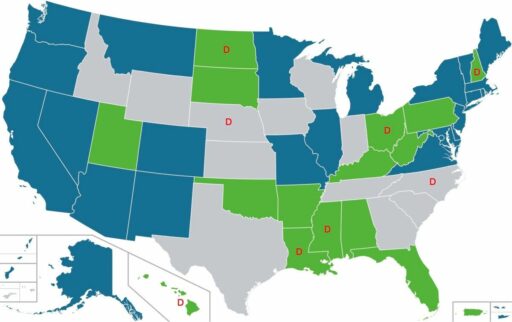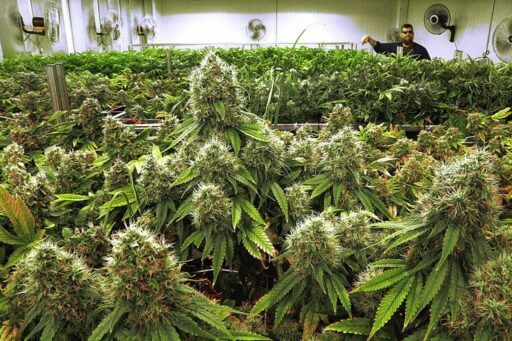The legalization of marijuana in California has been a transformative journey with significant implications across legislative, economic, social, and cultural landscapes. As we delve into the green wave that has swept through the state, it’s crucial to understand the multifaceted impact of legal cannabis—from the evolving regulations to the burgeoning business opportunities, shifts in public perception, and the challenges of compliance. This article explores these dimensions to offer a comprehensive view of the current state and future prospects of legal marijuana in California.
Key Takeaways
- California’s progressive cannabis laws, notably under Gov. Newsom’s administration, have set the stage for a robust legal market and social justice reforms.
- The CalCannabis Appellations Project is pioneering place-based branding in the cannabis industry, similar to the wine industry’s appellation system.
- Legal cannabis has created a ripple effect in the economy, influencing employment, wage laws, and sparking new lifestyle trends such as the pairing of natural wine and cannabis.
- Cannabis companies in California face the intricate challenge of navigating compliance with both state and federal laws, including data privacy and housing regulations.
- Innovations in technology and predictive consumer behavior analysis are shaping the future of California’s cannabis market, with legislative reforms on the horizon.
Legislative Landscape: California’s Marijuana Laws and Regulations

Gov. Newsom’s Recent Legalization Efforts
Under the leadership of Governor Gavin Newsom, California has seen a progressive shift in its approach to marijuana legislation. Newsom’s administration has been pivotal in the enactment of new laws that aim to refine the state’s cannabis industry and address past injustices associated with marijuana convictions.
Key measures include:
- The introduction of bills to streamline the regulatory process for cannabis businesses.
- Efforts to expand research on medical marijuana.
- Initiatives to support the expungement of criminal records for non-violent marijuana-related offenses.
The focus on restorative justice and economic development has been a cornerstone of Newsom’s policy, reflecting a broader commitment to rectify the long-term impacts of marijuana prohibition.
The administration’s actions have also spurred discussions on the future of cannabis in California, with stakeholders from various sectors actively engaging in shaping the evolving legislative landscape.
The CalCannabis Appellations Project
The CalCannabis Appellations Project represents a significant step in the evolution of the legal marijuana industry in California. It aims to establish a system similar to the wine industry’s appellations, designating cannabis products with a specific geographic origin and characteristics. This initiative not only promises to enhance the marketability of regional cannabis but also to protect the integrity and unique qualities of strains developed in distinct Californian locales.
The project underscores the importance of place-based branding in the cannabis sector, offering a unique value proposition to consumers seeking authenticity and quality.
The implications of the Appellations Project are manifold, including:
- The promotion of sustainable and organic farming practices.
- Encouragement of smaller, artisanal cannabis growers.
- Strengthening the identity of California’s cannabis culture.
As the project unfolds, it will be crucial for stakeholders to navigate the regulatory framework effectively to capitalize on the opportunities presented by this novel approach to cannabis branding.
Consumer Protection and Compliance Scrutiny
In the evolving landscape of California’s legal marijuana market, consumer protection has become a focal point for regulators and businesses alike. The introduction of initiatives like Real California Cannabis underscores the state’s commitment to ensuring that consumers are educated about the importance of purchasing cannabis products from licensed and compliant sources. This initiative is a proactive step in safeguarding public health and maintaining the integrity of the legal cannabis market.
To further enhance consumer protection, California has implemented a series of compliance measures aimed at monitoring and regulating the burgeoning industry. These measures include stringent product testing, labeling requirements, and the tracking of cannabis products from seed to sale. The goal is to provide transparency and accountability, thereby instilling confidence in consumers that the products they purchase are safe, accurately labeled, and legally produced.
The emphasis on compliance scrutiny is not just about adhering to regulations; it’s about building a sustainable industry that prioritizes consumer trust and safety.
While the regulatory framework continues to evolve, businesses operating within the cannabis space must navigate a complex web of state mandates. Staying abreast of these regulations is crucial for maintaining licensure and avoiding penalties. The table below outlines some of the key compliance areas and the associated requirements for cannabis businesses in California.
Economic Ripple Effects: The Business of Legal Weed

Cannabis Market Trends and Predictions
The cannabis market in California has experienced significant fluctuations in recent years. California’s Adult-Use Cannabis Market Eclipsed $5.1 Billion in its peak year, showcasing the potential of the industry. However, recent data indicates a downturn, with overall cannabis sales declining 8.4% to $4.9 billion in 2022. This includes $4.54 billion in adult-use and $360 million in medical cannabis sales.
Despite the recent dip in sales, the market trends suggest a maturing industry that is beginning to stabilize. Factors such as market saturation, regulatory changes, and consumer preferences are shaping the future landscape.
The following table summarizes the recent market trends:
| Year | Adult-Use Sales | Medical Sales | Total Sales |
|---|---|---|---|
| 2021 | $5.1 Billion | N/A | N/A |
| 2022 | $4.54 Billion | $360 Million | $4.9 Billion |
Analysts predict that the market will continue to evolve, with a focus on innovation, consumer education, and quality assurance becoming increasingly important for businesses seeking to thrive in this competitive space.
Impact on Employment and Wage Laws
The legalization of marijuana in California has ushered in significant changes to employment and wage laws. Employers must now navigate a complex landscape of regulations that balance the rights of employees with workplace safety and compliance. Notably, under two new laws effective in 2024, employers are prohibited from inquiring about an employee’s cannabis use outside of work hours and are restricted from using traditional hair or urine tests to detect such usage.
The shift in legislation reflects a broader movement to protect employee privacy and align employment practices with the evolving legal status of cannabis.
These changes have implications for various aspects of human resources, including hiring practices, employee handbooks, and drug testing policies. Employers are advised to review and update their protocols to ensure they are in compliance with the new standards, avoiding potential legal pitfalls.
The Role of Cannabis in Place-Based Branding
The legalization of marijuana in California has opened up new avenues for place-based branding, a concept where products are marketed based on their geographical origin and the unique qualities associated with that location. This approach has been successfully utilized in the wine industry and is now being applied to cannabis, with the CalCannabis Appellations Project at the forefront of this movement.
- The project aims to establish appellations, or legally recognized growing regions, for cannabis.
- It emphasizes the distinct characteristics and cultivation practices of each region.
- This initiative is expected to enhance consumer trust and support local economies.
The integration of cannabis into place-based branding strategies not only boosts market differentiation but also fosters a deeper connection between consumers and the product’s origin. It’s a testament to the plant’s cultural and economic significance in California.
As the industry matures, the importance of branding based on location is likely to grow, with consumers increasingly interested in the story behind their purchases. This trend could lead to a more sophisticated market where the provenance of cannabis is as important as the product itself.
Social and Cultural Shifts: Public Perception and Consumption

Changing Attitudes Toward Marijuana Use
The legalization of marijuana in California has led to a significant shift in public perception. Once stigmatized, cannabis is now gaining acceptance as a legitimate option for recreation and wellness. This change is reflected not only in the growing number of users but also in the broader cultural integration of marijuana-related products and services.
- Marijuana News website and similar platforms have emerged, featuring articles on a wide range of cannabis-related topics, from health benefits to industry news.
- The debate around marijuana has evolved, with discussions now focusing on its potential role in harm reduction, especially in relation to opioid addiction.
- Social acceptance has paved the way for new lifestyle trends, intertwining cannabis with other industries such as natural wine.
The potential for cannabis as a substitute for opioid pain relief has attracted considerable attention; observational studies suggest a correlation between legalization and a decrease in opioid-related deaths.
However, concerns about the balance between accessibility and addiction risk persist. The challenge lies in ensuring that regulation prioritizes public health while acknowledging the evolving attitudes towards marijuana use.
The Intersection of Cannabis and Social Justice
The intersection of cannabis and social justice is a complex and evolving issue. Cannabis social equity programs aim to address the historical injustices caused by the War on Drugs by providing opportunities to those disproportionately affected. However, questions arise about the inclusivity and effectiveness of these programs. Should they extend beyond racial equity to encompass women and LGBTQ+ people, as suggested by the title ‘Are Cannabis Social Equity Programs Truly Equitable?’
The California cannabis industry has seen individuals like Anthony, with a background in technology, pivot towards advocating for responsible cannabis policy and social justice reform. His journey underscores the personal connections that drive the push for change within the industry.
The booming billion-dollar cannabis industry coexists with the harsh reality of those who have suffered under past drug policies. It’s essential to represent and support cannabis prisoners, victims of the War on Drugs, and their families, ensuring that the benefits of legalization are equitably shared.
As the industry continues to grow, connecting with industry leaders and shaping the conversation on cannabis in California becomes increasingly important. The role of social media and market strategies, such as maintaining shelf space, are also critical in driving business growth within this socially conscious framework.
Natural Wine and Cannabis: A New Lifestyle Trend?
In the realm of refined indulgence, the pairing of wine and cannabis is not just an emerging trend but a sophisticated practice. This combination is gaining traction among connoisseurs who appreciate the nuanced experiences offered by both. The synergy between the complex flavors of natural wines and the aromatic profiles of cannabis strains creates a new dimension of sensory enjoyment.
The sophistication of this pairing is reflected in the growing number of events and social gatherings that celebrate the fusion of these two worlds. It’s a testament to the evolving public perception and the desire for more curated lifestyle choices.
While still in its infancy, the wine and cannabis pairing movement is poised for growth. Here are some key points to consider:
- The importance of understanding the complementary flavors and effects of different cannabis strains and wine varietals.
- The potential for specialized events and tastings that cater to this niche market.
- The role of knowledgeable guides or sommeliers in navigating the sophisticated journey of wine and cannabis pairing.
As this trend continues to develop, it will be interesting to observe how it shapes the social and cultural landscape, particularly in regions like California where both industries are prominent.
Navigating Compliance: The Challenge for Cannabis Companies

Balancing State and Federal Law
Cannabis companies in California face the complex task of adhering to both state regulations and federal guidelines, which often conflict. The dichotomy between state legality and federal prohibition creates a precarious legal landscape for businesses. For instance, while marijuana is legal for recreational use in California, it remains a Schedule I controlled substance under federal law.
- Federal law prohibits the use of banking services for cannabis-related businesses, leading to a largely cash-based industry.
- State compliance requires meticulous adherence to licensing, product testing, and packaging regulations.
- The tension between state and federal law complicates tax compliance, as businesses may not deduct cannabis-related expenses under federal tax law.
The legislation requires covered employers to reconsider their drug testing policies by January 1, 2024, reflecting the evolving legal environment and the need for updated workplace practices.
The upcoming changes, such as those outlined in the [California Cannabis Laws 2024](https://disa.com/news/weed-at-work-update-on-cannabis-in-california): AB 2188 Updates, signal a shift towards greater alignment between state policies and the realities of the cannabis industry. This evolution underscores the importance of staying informed and agile in the face of legal developments.
Data Privacy and the Cannabis Industry
In the evolving landscape of California’s legal cannabis market, data privacy emerges as a pivotal concern for both consumers and businesses. The Department of Cannabis Control (DCC) has taken steps to address this by implementing data dashboards that transform licensing and track-and-trace system data into actionable insights.
With the increasing digitization of cannabis transactions, safeguarding sensitive information is paramount. Companies must navigate complex regulations to protect consumer data while ensuring compliance.
The intersection of data privacy and the cannabis industry involves several key areas:
- Ensuring the security of customer information
- Complying with state and federal privacy laws
- Balancing transparency with confidentiality
- Adopting best practices for data management
As the industry grows, so does the importance of robust data privacy strategies to maintain consumer trust and meet regulatory standards.
New Housing Bills and Cannabis Business Locations
The interplay between new housing legislation and the placement of cannabis businesses is becoming increasingly complex. California’s recent housing bills aim to streamline the development process, potentially affecting where cannabis companies can establish their operations. These legislative changes are crucial for businesses seeking to navigate local zoning laws and community agreements.
- S.B. 213: A bill proposing changes to how local governments review new housing projects, which may impact available locations for cannabis businesses.
- Local development restrictions: Often dictate where cannabis companies can set up shop, and any changes to these can significantly alter the business landscape.
- Statewide ban on rent control: Repeal efforts could influence the real estate market, affecting both residential and commercial properties, including those used by cannabis companies.
The synergy between housing policy and cannabis business locations underscores the need for companies to stay informed and adaptable to legislative shifts. Keeping abreast of policy changes can be the difference between thriving and merely surviving in this dynamic industry.
Future Outlook: Innovations and Predictions for California Cannabis

Technological Advancements in Cannabis Cultivation
The cannabis industry in California is witnessing a surge in technological innovations that are revolutionizing cultivation practices. Precision agriculture is at the forefront, utilizing data analytics and IoT devices to optimize growing conditions and enhance crop yields. This approach not only improves product quality but also promotes sustainability by reducing resource waste.
Advancements in LED lighting technology have allowed cultivators to tailor light spectra to the specific needs of cannabis plants, leading to more efficient energy use and potentially higher cannabinoid content. Automated systems for watering, nutrient delivery, and climate control are becoming increasingly sophisticated, enabling growers to maintain ideal conditions with minimal manual intervention.
Another significant development is the rise of cannabis testing technologies. As the market matures, the demand for consistent, high-quality products is paramount. Laboratories like Encore Labs are at the cutting edge, offering comprehensive testing services to ensure safety and quality. This focus on cannabis testing innovations is a testament to the industry’s commitment to consumer protection and regulatory compliance.
The integration of these technologies is not just enhancing the efficiency and output of cannabis cultivation; it’s setting new standards for the entire agricultural sector.
Predictive Analysis of Consumer Behavior
In the evolving landscape of California’s legal cannabis market, predictive analysis is becoming an indispensable tool for businesses. This is where data analytics steps in, providing a game-changing perspective for making sense of the massive datasets present in today’s cannabis industry. By examining patterns of use and market trends, companies can anticipate consumer needs and adjust their strategies accordingly.
The ability to predict how supply and demand drivers influence drug initiation and transitions is crucial for staying ahead in the competitive market.
Understanding the sequence of drug use progression is also vital. For instance, the analysis of whether the use of one product tends to precede another can inform marketing and product development strategies. Here’s a simplified view of the factors influencing consumer behavior:
- SUPPLY AND DEMAND DRIVERS
- Patterns of drug use progression
- Market trends and popular substances
With the right analytical tools, businesses can navigate the complex interplay of these factors to optimize their offerings and capture emerging opportunities.
Legislative Forecasts and Potential Reforms
As California continues to navigate the complexities of legal marijuana, legislative forecasts indicate a dynamic future for cannabis laws and potential reforms. A notable development is the 2024 California law that will protect workers using cannabis on their own time, signaling a shift towards more employee-friendly policies in the state. This law, however, will exclude certain groups such as construction workers, highlighting ongoing debates around workplace safety and impairment.
The evolving legal landscape suggests that California may continue to refine its approach to cannabis regulation, balancing consumer freedoms with public safety concerns.
Looking ahead, stakeholders are anticipating further legislative activity that could reshape the industry:
- Clarification and expansion of cannabis appellation designations
- Enhanced consumer protection measures
- Revisions to tax structures to support small businesses
- Greater alignment of state and federal policies
These potential reforms are poised to influence not only the cannabis industry but also the broader socio-economic fabric of California.
Conclusion
As we navigate the green wave of legal marijuana in California, it’s clear that the impact is multifaceted, touching on legal, economic, and social spheres. The state has seen a surge in place-based branding, increased scrutiny on consumer protection, and evolving employment laws to accommodate this new landscape. With the passage of new legislation and the ongoing adjustments to regulatory frameworks, California continues to shape the conversation on cannabis, setting trends that ripple beyond its borders. The green wave is not without its challenges, but it also presents opportunities for innovation, growth, and social change. As the industry matures, it will be crucial for stakeholders to remain informed and adaptable to the shifting tides of cannabis legalization and its implications for the Golden State.
Frequently Asked Questions
What are the recent efforts by Gov. Newsom regarding marijuana legalization in California?
Gov. Newsom has signed new laws aimed at regulating and supporting the legal cannabis industry, including efforts to bolster consumer protection and ensure compliance with state regulations.
What is the CalCannabis Appellations Project?
The CalCannabis Appellations Project is an initiative to establish appellations of origin for cannabis grown in California, similar to the wine industry, to promote place-based branding and protect regional cannabis characteristics.
How has the legalization of marijuana impacted employment and wage laws in California?
Legalization has led to new employment opportunities and has necessitated updates to wage laws and employer marijuana testing to adapt to the growing cannabis industry.
How are public perceptions of marijuana use changing in California?
Attitudes toward marijuana use are becoming more positive, with an increasing acceptance of cannabis as part of lifestyle trends, such as pairing with natural wine, and recognition of its potential social justice implications.
What challenges do cannabis companies face in navigating state and federal laws?
Cannabis companies must balance compliance with state laws where marijuana is legal with the ongoing federal prohibition, creating challenges in areas such as banking, taxation, and interstate commerce.
What technological advancements are expected in California’s cannabis cultivation?
Technological advancements in cannabis cultivation are anticipated to improve efficiency, yield, and sustainability, with innovations such as predictive analysis of consumer behavior shaping the industry’s future.





